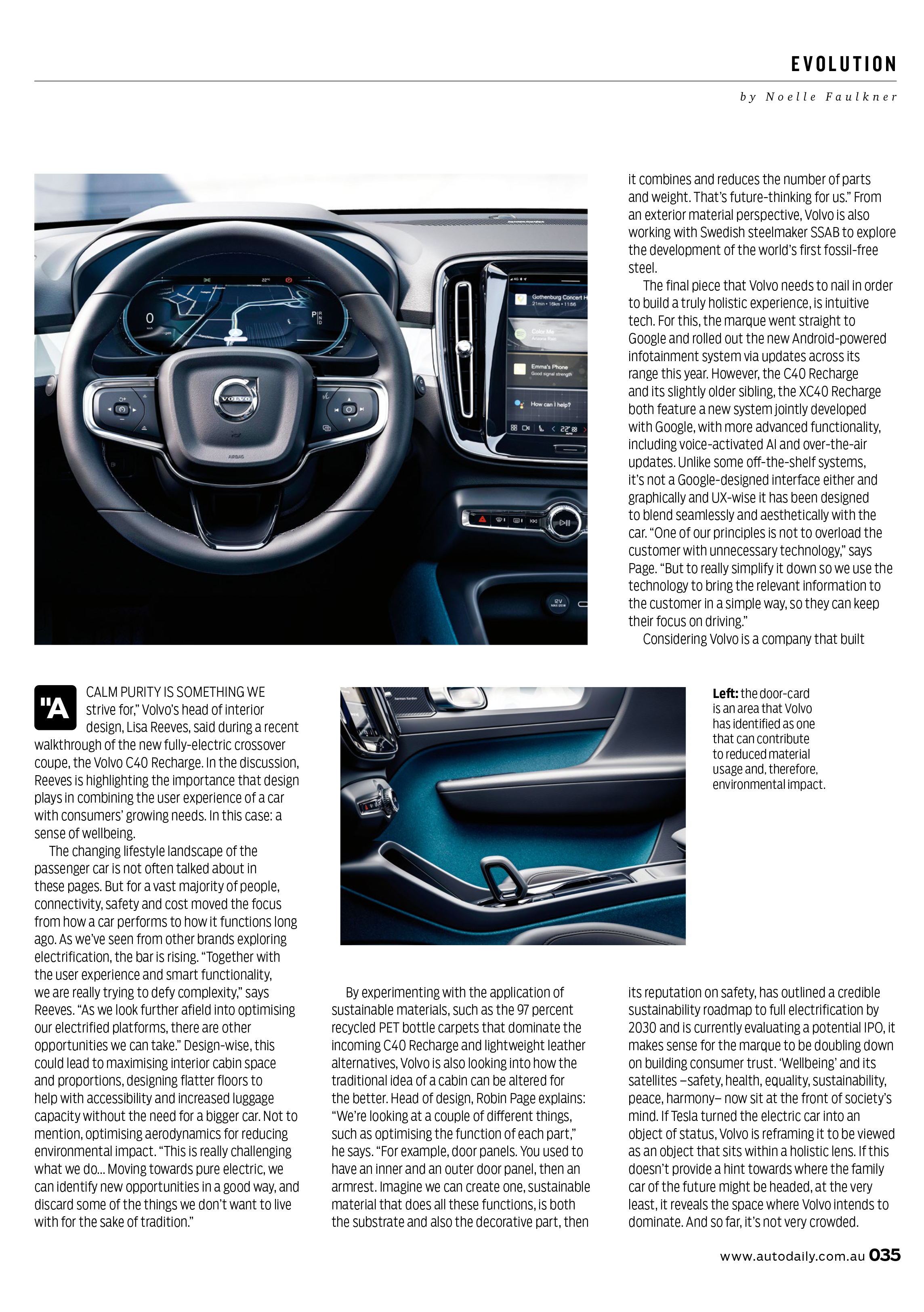
evo Australia, July 2021 (PDF)
Versatility, tranquillity and connectivity, how Volvo is designing the future it wants to lead
"A calm purity is something we strive for,” Volvo’s head of interior design, Lisa Reeves, said during a recent walkthrough of the new fully-electric crossover coupe, the Volvo C40 Recharge. In the discussion, Reeves is highlighting the importance that design plays in combining the user experience of a car with consumers’ growing needs. In this case: a sense of wellbeing.
The changing lifestyle landscape of the passenger car is not often talked about in these pages. But for a vast majority of people, connectivity, safety and cost moved the focus from how a car performs to how it functions long ago. As we’ve seen from other brands exploring electrification, the bar is rising. “Together with the user experience and smart functionality, we are really trying to defy complexity,” says Reeves. “As we look further afield into optimising our electrified platforms, there are other opportunities we can take.” Design-wise, this could lead to maximising interior cabin space and proportions, designing flatter floors to help with accessibility and increased luggage capacity without the need for a bigger car. Not to mention, optimising aerodynamics for reducing environmental impact. “This is really challenging what we do... Moving towards pure electric, we can identify new opportunities in a good way, and discard some of the things we don’t want to live with for the sake of tradition.”
By experimenting with the application of sustainable materials, such as the 97 percent recycled PET bottle carpets that dominate the incoming C40 Recharge and lightweight leather alternatives, Volvo is also looking into how the traditional idea of a cabin can be altered for the better. Head of design, Robin Page explains: “We’re looking at a couple of different things, such as optimising the function of each part,” he says. “For example, door panels. You used to have an inner and an outer door panel, then an armrest. Imagine we can create one, sustainable material that does all these functions, is both the substrate and also the decorative part, then it combines and reduces the number of parts and weight. That’s future-thinking for us.” From an exterior material perspective, Volvo is also working with Swedish steelmaker SSAB to explore the development of the world’s first fossil-free steel.
The final piece that Volvo needs to nail in order to build a truly holistic experience, is intuitive tech. For this, the marque went straight to Google and rolled out the new Android-powered infotainment system via updates across its range this year. However, the C40 Recharge and its slightly older sibling, the XC40 Recharge both feature a new system jointly developed with Google, with more advanced functionality, including voice-activated AI and over-the-air updates. Unlike some off-the-shelf systems, it’s not a Google-designed interface either and graphically and UX-wise it has been designed to blend seamlessly and aesthetically with the car. “One of our principles is not to overload the customer with unnecessary technology,” says Page. “But to really simplify it down so we use the technology to bring the relevant information to the customer in a simple way, so they can keep their focus on driving.”
Considering Volvo is a company that built its reputation on safety, has outlined a credible sustainability roadmap to full electrification by 2030 and is currently evaluating a potential IPO, it makes sense for the marque to be doubling down on building consumer trust. ‘Wellbeing’ and its satellites –safety, health, equality, sustainability, peace, harmony– now sit at the front of society’s mind. If Tesla turned the electric car into an object of status, Volvo is reframing it to be viewed as an object that sits within a holistic lens. If this doesn’t provide a hint towards where the family car of the future might be headed, at the very least, it reveals the space where Volvo intends to dominate. And so far, it’s not very crowded.

